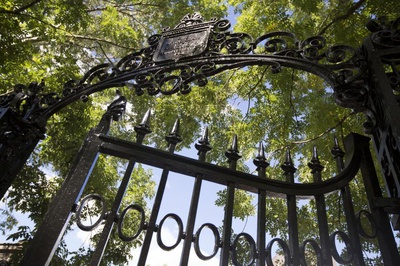
News
Harvard Grad Union Agrees To Bargain Without Ground Rules

News
Harvard Chabad Petitions to Change City Zoning Laws

News
Kestenbaum Files Opposition to Harvard’s Request for Documents

News
Harvard Agrees to a 1-Year $6 Million PILOT Agreement With the City of Cambridge

News
HUA Election Will Feature No Referenda or Survey Questions
Massive Meteor May Have Supercharged Early Microbial Life on Earth, Harvard Study Finds

A meteorite 200 times larger than the one that wiped out Earth’s dinosaurs may have been critical for the development of early microbial life on the planet three billion years ago, according to a Harvard study published last week.
The findings are a striking example of how what is usually regarded as a kind of ecological disaster actually brought a “bio-essential” element — phosphorus — “across the entire globe,” according to Earth and Planetary Sciences professor Nadja Drabon, the study’s lead author. Drabon and her team’s findings were published in the Proceedings of the National Academy of Science.
During the time of impact, Earth was starkly different than today — composed of little life and resembling what Drabon called a “water world” with mostly oceans, few land masses, and “almost no free oxygen in the atmosphere.”
Drabon described the meteorite as a “fertilizer bomb,” adding that since the planet’s oceans at the time would have been “really phosphorus limited.”
“This would have really helped life flourish,” Drabon said.
The meteorite itself, referred to as S2 in Drabon’s study, was between 37 and 58 km wide, according to the study. Alec R. Brenner, one of the study’s authors and a former EPS graduate student, said that the crater would have spanned a distance “pretty much all the way from New York City to northern Maine.”
To conduct their research, Drabon and her team traveled to the Barberton Greenstone Belt in South Africa, known for hosting well-preserved samples of some of the oldest sedimentary and volcanic rock in the world. The rare site is useful to study physical remnants of the earth’s earliest moments, according to Drabon.
The scientists used complex geochemical techniques to analyze the samples on one of the smallest scales possible, which Stefano M. Bernasconi, a professor at ETH Zurich who analyzed carbon isotopes for the meteorite, called “challenging.”
“It was a bit of a challenging question because the concentrations were very small,” he said, adding that the small size forced them to grind up their samples to release tiny grains of carbonate which were trapped in non-reactive minerals.
Drabon said that the work is “leading to a whole new line of research,” adding that she wants to “look at other evidence for microbes” and their interaction with other kinds of chemical isotopes.
“In the Barberton Greenstone Belt we have evidence for seven more impact events, all of them either the same size or bigger than the one that killed the dinosaurs. So there's plenty opportunity to now look at other impact events and see how those affected the environment and life,” Drabon said. “There’s many different projects that are coming out of this.”
Want to keep up with breaking news? Subscribe to our email newsletter.
Most Read
- Harvard Dismisses Leaders of Center for Middle Eastern Studies
- More Than 80 HLS Professors Denounce Trump Admin Attacks on Law Firms in Letter to Students
- 2 Years After Affirmative Action Ruling, Harvard Admits Class of 2029 Without Releasing Data
- Harvard Agrees to a 1-Year $6 Million PILOT Agreement With the City of Cambridge
- FAS Dean Asks Center Directors To Show Compliance With Viewpoint Diversity Guidance
From Our Advertisers

Over 300+ courses at prestigious colleges and universities in the US and UK are at your disposal.

With innovative financial tools combined with financial education, Collegiate empowers students to take control of their finances and build confidence in their money management skills.

Serve as a proctor for Harvard Summer School (HSS) students, either in the Secondary School Program (SSP), General Program (GP), or Pre-College Program.

With an increasingly competitive Law School admissions process, it's important to understand what makes an applicant stand out.

Welcome to your one-stop gifting destination for men and women—it's like your neighborhood holiday shop, but way cooler.

Admit Expert is a premium MBA admissions consulting company, helping candidates secure admission to top B-schools across the globe with significant scholarships.
